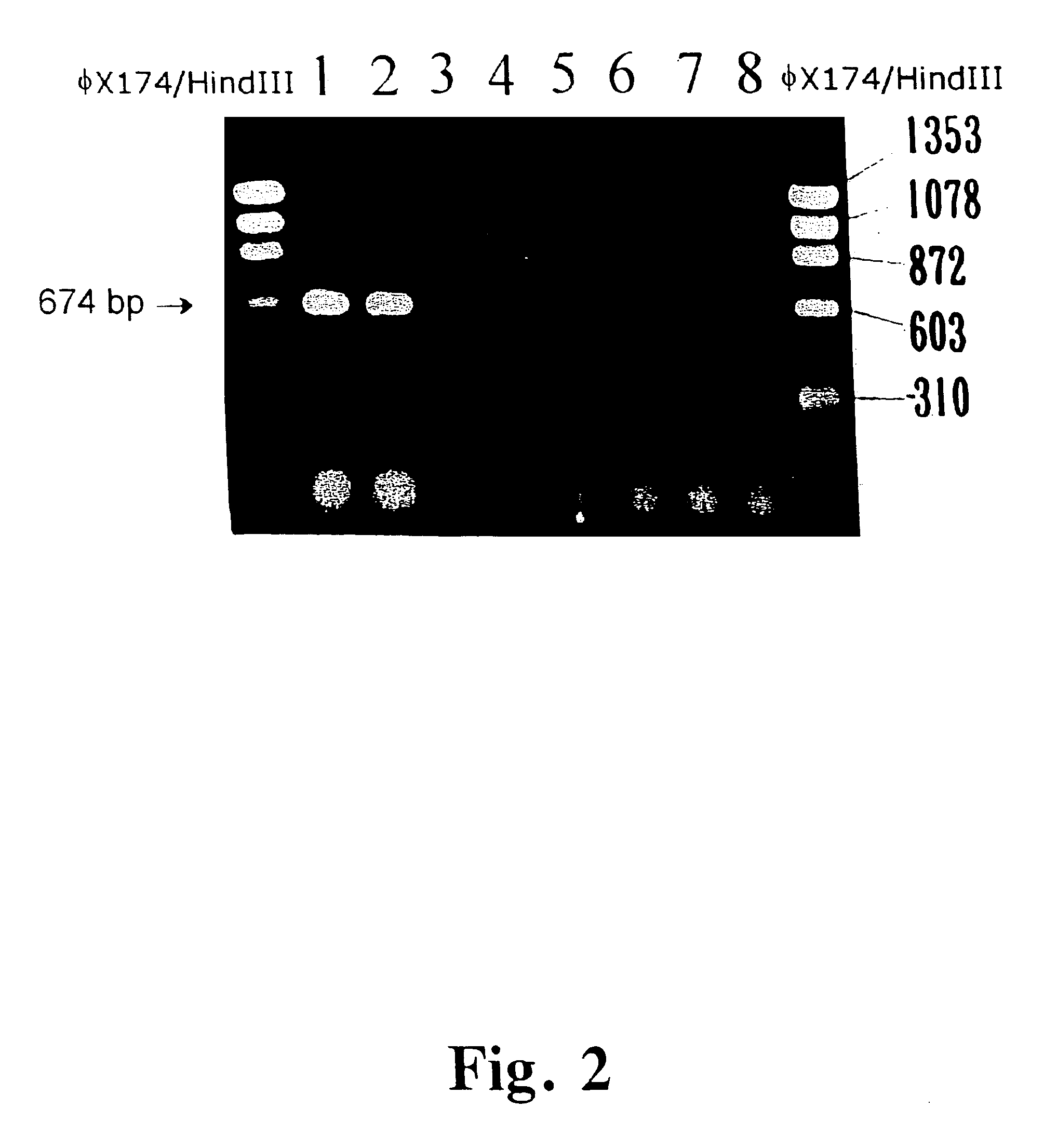Diagnosis of penaeus monodon-type baculovirus by PCR
a penaeus monodon and baculovirus technology, applied in the field of pcr detection of occluded baculovirus, can solve the problems of not being used to detect occluded baculovirus, substantial losses in shrimp production,
- Summary
- Abstract
- Description
- Claims
- Application Information
AI Technical Summary
Benefits of technology
Problems solved by technology
Method used
Image
Examples
first embodiment
the invention provides for a polymerase chain reaction (PCR) method to detect MBV using two pairs of primers specific to MBV genomic DNA. The first pair of primers is designed from the conserved sequences of the DNA polymerase genes of NPVs. The DNA polymerase genes share 40%-50% sequence homology among insect baculoviruses (Bjornson et al., J. General Virol. 73:3177-3183, supra), which are much more diverse than the polyhedrin genes of nuclear polyhedrosis viruses (NPVs) (which share a 80% sequence homology among insect baculoviruses). The PCR method using a pair of primers designed from the conserved sequences of the DNA polymerase genes is therefore more selective than that of polyhedrin genes.
P1 and P2 are the preferable first pair of primers. They are derived from the DNA polymerase gene of MBV. P1 and P2 are designed according to a pair of conserved sequences (i.e., Primer 1 and Primer 2, SEQ ID NO:7 and SEQ ID NO:8) taken out from the DNA polymerase genes of Autographa califo...
example 1
Isolation and Purification of MBV Occlusion Bodies from Infected Postlarvae of Tiger Prawns
Postlarvae of black tiger prawns suspected to be infected with MBV were randomly examined by staining smeared specimens with eosin to look for occlusion bodies, an indication of MBV infection. Positive MBV-infected postlarvae were frozen and stored on dry ice.
About 500 g of frozen MBV-infected postlarvae were placed in a 1 L beaker and quickly thawed in a 37.degree. C. water bath. They were homogenized with a polytron homogenizer in 20 mM Tris-HCl (pH 7.8) at 4.degree. C. The homogenate was filtered through 300-mesh nylon, and the filtrate was centrifuged at 1,000.times.g for 10 minutes at 4.degree. C. The pellet was resuspended and emulsified in an organic solvent mixture (20 mM Tris-HCl: n-butanol: n-hexane=10:4:1). After centrifugation again at 2000.times.g for 20 minutes at 40.degree. C., the pellet was extracted once again with the organic solvent mixture, before being resuspended in Tris...
example 2
Isolation of MBV Genomic DNA
An aliquot of the MBV occlusion body suspension containing 20 .mu.g of protein as determined by Bradford assay was added to 1 ml of TN buffer (10 mM Tris-HCl, pH 8.0, 100 mM NaCl), and digested with proteinase K (100 .mu.g / ml) at 37.degree. C. for 30 minutes. Then, 25 .mu.l of concentrated sodium lauryl sarkosome solution (10%, W / V) and 0.1 volume of 5 M NaCl were added to the reaction mixture in a microfuge tube and mixed on a vortex mixer, which was followed by adding 0.15 volumes of cetyltrimethyl-ammonium bromide (CTAB) / NaCl (10% CTAB in 0.7 M NaCl) with mixing and heating at 65.degree. C. for 30 minutes. The final mixture was extracted once with an equal volume of phenol / chloroform. The supernatant was further extracted twice with an equal volume of phenol / chloroform / isoamyl alcohol (25:24:1). MBV DNA in the supernatant was then precipitated with 0.6 volumes of isopropanol at room temperature. After centrifugation at 13,000.times.g for 15 minutes, t...
PUM
| Property | Measurement | Unit |
|---|---|---|
| temperature | aaaaa | aaaaa |
| temperature | aaaaa | aaaaa |
| pH | aaaaa | aaaaa |
Abstract
Description
Claims
Application Information
 Login to View More
Login to View More - R&D
- Intellectual Property
- Life Sciences
- Materials
- Tech Scout
- Unparalleled Data Quality
- Higher Quality Content
- 60% Fewer Hallucinations
Browse by: Latest US Patents, China's latest patents, Technical Efficacy Thesaurus, Application Domain, Technology Topic, Popular Technical Reports.
© 2025 PatSnap. All rights reserved.Legal|Privacy policy|Modern Slavery Act Transparency Statement|Sitemap|About US| Contact US: help@patsnap.com



